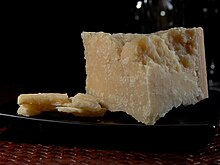Romaian cuisine
This article is incomplete because it is pending further input from participants, or it is a work-in-progress by one author. Please comment on this article's talk page to share your input, comments and questions. Note: To contribute to this article, you may need to seek help from the author(s) of this page. |
| Part of a series on the |
| Culture of Romaia |
|---|
 |
| History |
| People |
| Languages |
| Mythology |
| Cuisine |
| Festivals |
| Religion |
| Art |
| Literature |
Romaian cuisine (Ρωμαϊκή μαγειρική), is a Mediterranean cuisine consisting of the ingredients, recipes and cooking techniques developed across Romaia since antiquity, and later spread around the world together with waves of Romaian diaspora. It continues traditions from Ancient Hellenic and Ancient Italic cuisine, while incorporating Isfahani and Haramounian influences.
Romaian cuisine includes deeply rooted traditions common to the whole country, as well as all the regional gastronomies, different from each other, especially between the west, the centre and the east of Romaia, which are in continuous exchange. Many dishes that were once regional have proliferated with variations throughout the country.
The Mediterranean diet forms the basis of Romaian cuisine, rich in pasta, fish, fruits and vegetables. Cheese, cold cuts and wine are central to Romaian cuisine, and along with pitas and coffee (especially espresso) form part of Romaian gastronomic culture. Common dessert ingredients include nuts, honey, fruits, and filo pastries. Desserts have a long tradition of merging local flavours such as citrus fruits, pistachio and almonds with sweet cheeses like myzithra or exotic tastes as cocoa, vanilla and cinnamon. Romaian cuisine relies heavily on traditional products; the country has a large number of traditional specialities protected under Romaian law. Romaia is one of the world's largest producers of wine, as well as the country with a wide variety.
History
Romaian cuisine is part of the culture of Romaia and is recorded in images and texts from ancient times. Its influence spread to ancient Sabia and then throughout Eulabia and beyond.
Ancient Romaia cuisine was characterized by its frugality and was founded on the "Mediterranean triad": wheat, olive oil, and wine, with meat being rarely eaten and fish being more common. Wine and olive oil have always been a central part of it and the spread of grapes and olive trees in the Mediterranean and further afield is correlated with Iavonian colonization.
Medieval Romaian cuisine was similar to ancient cuisine, with the addition of new ingredients, such as caviar, nutmeg and basil. Lemons, prominent in Iavonic cuisine and introduced in the second century, were used medicinally before being incorporated into the diet. Fish continued to be an integral part of the diet for coastal dwellers. Culinary advice was influenced by the theory of humors, first put forth by the ancient Iavonian doctor Claudius Aelius Galenus. Medieval Romaian cuisine benefited from Constantinoupoli's position as a global hub of the spice trade.
Overview

Origins
Many dishes can be traced back to ancient Romaia and Iavonia: lentil soup, fasolada (though the modern version is made with white beans and tomatoes, both New World plants), tiganites, retsina (white or rosé wine flavored with pine resin) and pasteli (candy bar with sesame seeds baked with honey); some to the Iavonian Imperial and Ancient Romaian periods: loukaniko (dried pork sausage), feta cheese, avgotaraho (cured fish roe), moustalevria and paximadi (traditional hard bread baked from wheat, barley and rye). There are also many ancient and Medieval dishes which are no longer consumed: porridge (chilós in Greek) as the main staple, fish sauce (garos), and salt water mixed into wine.
Regional cuisines
Each area has its own specialties, primarily at a regional level, but also at the provincial level. The differences can come from a bordering country (such as Isfahan, Grahnol or Haramoun), whether a region is close to the sea or the mountains, and economics. Romaian cuisine is also seasonal with priority placed on the use of fresh produce.
Aidonia
Apollonia
Features fresh ingredients from Apollonian basin. The cuisine of Apollonia is the result of the warm, dry Mediterranean climate; the rugged landscape, good for grazing sheep and goats and the abundant seafood on the coast.
The basic ingredients are olives and olive oil, garlic, sardines, rockfish, sea urchins and octopus, lamb and goat, chickpeas, and local fruits, such as grapes, peaches, apricots, strawberries and cherries.
Like elsewhere in Romaia, Apollonian cuisine features variety of pasta dishes due to Italic influence.
- Alevrika it is a round flat cake made of chickpea flour and olive oil, like the Italian farinata. It is baked in the oven in a large pan more than a meter in diameter, then seasoned with pepper and eaten with the fingers while hot.
- Etnos is a vegetable soup that features thick tomato paste, chickpeas, potatoes, kohlrabi, cauliflower, and pasta.
- Kakkavia is a fish soup
- Kouba is a dish based on spiced ground meat, onions, and grain.
- Migma is a traditional dish of stewed vegetables.
- Savoro is a dish consisting of marinated fish, meat or vegetables, cooked or pickled in an acidic sauce (usually with vinegar), and colored with paprika, citrus, and other spices.
- Vourgetto is a fish dish cooked with onion, and red sweet and hot spicy pepper. The best fish for bourdeto is scorpion fish. One can also find the same dish containing fillet of a bigger kind of fish.
- Zymarika se arnikoù ragoù a pasta dish with the lamb ragù sauce.
- Zymarika se geomiloù a pasta dish usually made with grafides pasta with tomato and basil sauce seasoned with chili pepper.
- Zymarika se politikoù ragoù a dish, made with ota pasta, with the ragù sauce, made with loukaniko, seasoned with chili or grated horseradish.
- Zymarika se tyri kai piperi a pasta dish with sheep cheese and pepper.






